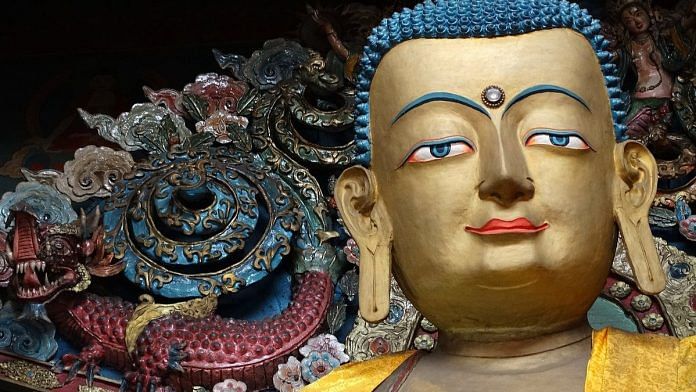It’s often argued that the ascent of Puranic Hinduism in the 5th century CE rapidly brought about the end of Buddhism in India. But in medieval Bengal, from the 8th to the 13th centuries CE, Buddhism commanded an enormous following. It pioneered religious innovations, challenged state structures, and retained the international connections that characterised it from its earliest days. And medieval Buddhism, like ancient Buddhism, was not uniform or closed off. Nor was it purely ‘Indian’. It incorporated ideas and deities, and responded to challenges, from the vast, borderless Indian Ocean world.
International Buddhism
Generations of archaeological work, conducted by both Indian and international scholars, offer us an unusually good picture of Bengal’s Buddhism. (I’ll use ‘Bengal’ to refer to both present-day West Bengal and Bangladesh). The northern part of Bengal was connected to the ancient monasteries and pilgrimage sites of Bihar. It had massive monastic institutions of its own, such as Somapura. The southern region, especially around the Ganga-Brahmaputra delta, was marshier and less densely settled. It was somewhat of a frontier, still being claimed for agriculture, and it saw significant political flux.
In Esoteric Buddhism in Mediaeval Maritime Asia, historians of Buddhism studied these developments in an Asian continental context. Up to the 5th century, Buddhism’s centre of gravity was in Northwest India, embedded in the overland trade of the Silk Roads. But once Arab power assimilated these trade networks in the 8th century, the Buddhist centre of gravity shifted toward the southeast, participating in overseas circulatory systems that included Burma, Java, and Sumatra. In her chapter ‘Images of Devotion and Power in South and Southeast Bengal’, distinguished archaeologist and art historian Claudine Bautze-Picron analysed sculptures from both of Bengal’s Buddhist regions.
Bautze-Picron argued that Buddhist institutions in Bengal had a degree of primacy in Indian Ocean networks, but Bengal was not the sole centre—and did not live in splendid isolation. Bengali Buddhists made advances in texts, iconography and rituals that drew in scholars from as far as Java and freely adopted ideas from them.
For example, Bautze-Picron points out that Sudhanakumara—a minor hero from an older Buddhist text—was quite popular in Java, where he was depicted on the colossal Borobudur temple in the 9th century. By the 10th century, he came to be worshipped in Bihar, as an attendant of more important deities. And by the 11th century, monks from Bengal—including the famed teacher Atisha Dipankara Srijnana, who later helped convert Tibet to Buddhism—were going to Sumatra and Java to complete their studies.
In his chapter ‘Traces of Indonesian Influences in Tibet’ (Esoteric Buddhism), historian Jan A Schoterman studied an illustrated Bengali manuscript from 1015, which discussed the major Buddhist sites of the time. Included in this list are sanctuaries in Java, Sumatra, and the Malay Peninsula. However, after Chola attacks on the region around 1026, many of these Southeast Asian sites fell off the Bengali Buddhist radar.
Also read: A Thai-Buddhist ‘Ayodhya’ was one of Asia’s greatest kingdoms. Then came a reckoning
A multi-religious environment
Around the same time, changes were afoot in Bengal itself. The Pala rulers of northern Bengal, struggling with the alienation of resources to massive monasteries, shifted toward patronising Brahmins. In southern Bengal, centred around present-day Bikrampur in Bangladesh, dynasties changed their affiliation to Vaishnavism and Shaivism. However, Buddhism still received patronage from lay communities well into the 13th century. Bautze-Picron reports that fine images of Surya, Vishnu and Shiva were found here, and their temples and worshippers were a major challenge to Buddhists.
Buddhists dealt with this in various ways. In her paper ‘From God to Demon, from Demon to God: Brahma and other Hindu deities in Late Buddhist Art of Eastern India’, Bautze-Picron shows that Buddhists commonly depicted Hindu gods, but appropriated them for their own reasons. Hindu gods were sometimes given “demonic” appearances with fangs, and were accompanied by other ghastly figures in the army of Mara, the tempter. Invariably, they were shown as defeated by the Buddha’s enlightenment or trampled by fierce Buddhist deities. They are then shown returning to their divine nature, peacefully learning from the Buddhists and accepting a subordinate position.
At Bikrampur, Bangladesh, from the 11th century, Hindus were dominant. Simultaneously, Buddhist images produced there began to adopt fiercer appearances—perhaps a result of international developments in Buddhism. Terrifying Buddhist deities such as Hevajra and Mahakala were popular in Cambodia and China at the time, serving as the protectors of the state. In Bengal, argues Bautze-Picron, they were instead worshipped as the protectors of Buddhist monasteries (while the state itself had turned to Hinduism). Nor was this iconographic fierceness confined to Buddhists. In Hardships and Downfall of Buddhism in India, archaeologist Giovanni Verardi discusses sculptures of the Hindu deity Chamunda, sometimes depicted wearing a garland of Buddha heads.
These might indicate violent confrontations between the two groups. Or it might be a broader trend of worshipping fierce deities in medieval religion. Either way, the sculptures of medieval Bengal reveal that it is impossible to think about Indian religions in isolation—they constantly interacted with each other and with the grand religious tapestry of the Indian Ocean world.
Anirudh Kanisetti is a public historian. He is the author of Lords of the Deccan, a new history of medieval South India, and hosts the Echoes of India and Yuddha podcasts. He tweets @AKanisetti. Views are personal.
This article is a part of the ‘Thinking Medieval‘ series that takes a deep dive into India’s medieval culture, politics, and history.
(Edited by Zoya Bhatti)



